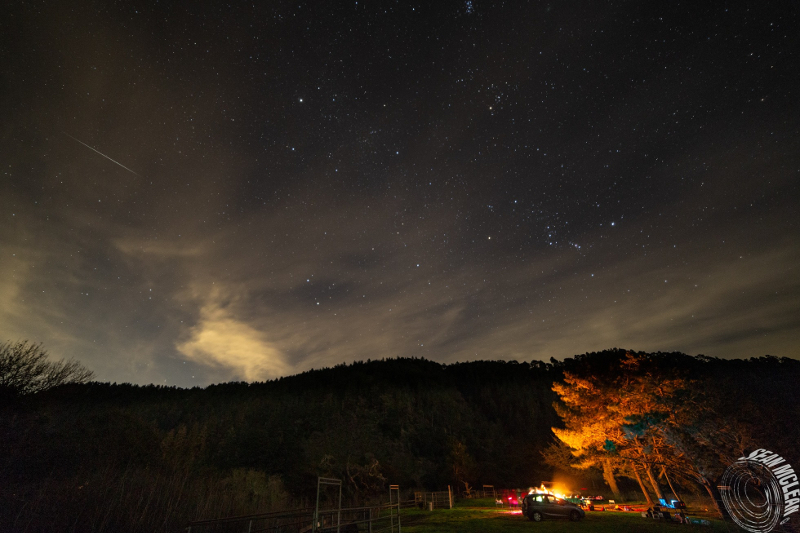
Campfire for the meteor watchers. You can see a meteor toward the upper left corner. The comet appears as a small white ball halfway down the photograph, on the right side, near a triangle of stars. (Photo by Sean McLean)
Bushcraft and astronomy go together.
It makes perfect sense when you think about it. Botany, ecology, natural history, and zoology – all enrich our outdoor experience. It’s the same for astronomy.
And if you take overnight trips into the wilderness, you see what few people experience in our modern society: A pure unadulterated sky.
What is Light Pollution?
Just a hundred years ago, you could look up at the night sky and see thousands of stars. The center of our galaxy, the Milky Way, appeared as a ribbon of white like a swift flowing stream. Our night sky has inspired thinkers, artists, poets, and lovers for the majority of human existence.
But today, few of us can see the ocean of stars that awed our ancient ancestors. This is because of light pollution. You may have heard about air pollution and water pollution. Light pollution is caused by artificial light from our towns and cities. Powerful lamps light streets, buildings, parking lots, and billboards. The sky-glow of Los Angeles is visible from an airplane 200 miles away1!
Light pollution washes out starlight, disrupts ecosystems, and wastes energy. It’s been shown to have negative effects on both flora and fauna. Light pollution also has adverse health effects on people. The artificial light disrupts people’s circadian clock resulting in sleep disorders. And there is a possible correlation with increased risk of cancer.
And tragically, most children in the United States never see that awe-inspiring sky.
The Geminids plus a Comet
I never pass up the chance to see a pure night sky. I grew up outside New York City. It wasn’t until my early twenties that I saw a sky with more than a dozen stars in it.
So I jumped at the chance to visit Big Basin Redwoods State Park during the peak of the Geminid Meteor Shower. The meteors are debris scattered from the mysterious rock-comet 3200 Phaethon. Every 1.43 years, pieces of the rock-comet enter our atmosphere at speeds of nearly 80,000 miles per hour. Atmospheric friction vaporizes them in colorful fireballs. It’s nature’s own fireworks show!
At the peak of the meteor shower, if the night is dark, it’s possible to see 50 meteors per hour. And you don’t need special equipment. All you need to do is look up!
I’ve seen the more famous Perseids meteor shower in July and August. But this is the first time I’ve braved the cooler weather to see the Geminids.
In 2018, we also received another gift – a comet! Comet 46P/Wirtanen is visible during the meteor shower. And several amateur astronomers set up telescopes for us to look through.
Connecting with the Cosmos
I arrive at our viewing site, just a half-mile inland from Waddell State Beach. I carry a fleece blanket to spread on the ground, a camp chair, a flashlight (with red LED), warm clothing, and a thermos of hot chocolate.
The rangers kindle a campfire. And we relish its warm embrace against the cold. Away from the fire, we set up the telescopes and blankets. The mountains to the East are draped like black curtains against the sky. The waves provide the soundtrack as we scan the sky for shooting stars.
May I express the inexpressible when I say the scene is timeless. A small group huddles around the campfire, chatting amiably. And the rest of us stand together in the darkness, searching the sky. Calling across the incalculable gulf between ourselves and the universe.
One of the astronomers sets up his camera to snap long-exposure photos of the sky. You can see a meteor toward the upper left corner. The comet appears as a small white ball halfway down the photograph, on the right side, near a triangle of stars.

Photo by Sean McLean
Best wishes
I wish you a bounty of natural wonders in the coming year. May all your skies be clear, and may all your trails lead you to happiness.
References
1. Missing the Dark: Health Effects of Light Pollution
For fun facts and useful tips, join the free Bushcraft Newsletter.



Leave a Comment